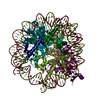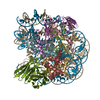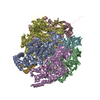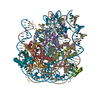[English] 日本語
 Yorodumi
Yorodumi- PDB-7e8i: Structural insight into BRCA1-BARD1 complex recruitment to damage... -
+ Open data
Open data
- Basic information
Basic information
| Entry | Database: PDB / ID: 7e8i | |||||||||||||||||||||||||||
|---|---|---|---|---|---|---|---|---|---|---|---|---|---|---|---|---|---|---|---|---|---|---|---|---|---|---|---|---|
| Title | Structural insight into BRCA1-BARD1 complex recruitment to damaged chromatin | |||||||||||||||||||||||||||
 Components Components |
| |||||||||||||||||||||||||||
 Keywords Keywords | NUCLEAR PROTEIN / BRCA1 / nucleosome / DNA damage / chromatin / BARD1 | |||||||||||||||||||||||||||
| Function / homology |  Function and homology information Function and homology informationnegative regulation of mRNA 3'-end processing / histone H2AK127 ubiquitin ligase activity / histone H2AK129 ubiquitin ligase activity / Defective DNA double strand break response due to BRCA1 loss of function / Defective DNA double strand break response due to BARD1 loss of function / BRCA1-BARD1 complex / BRCA1-B complex / BRCA1-A complex / BRCA1-C complex / ubiquitin-modified histone reader activity ...negative regulation of mRNA 3'-end processing / histone H2AK127 ubiquitin ligase activity / histone H2AK129 ubiquitin ligase activity / Defective DNA double strand break response due to BRCA1 loss of function / Defective DNA double strand break response due to BARD1 loss of function / BRCA1-BARD1 complex / BRCA1-B complex / BRCA1-A complex / BRCA1-C complex / ubiquitin-modified histone reader activity / nuclear ubiquitin ligase complex / DNA strand resection involved in replication fork processing / homologous recombination / tissue homeostasis / protein K6-linked ubiquitination / regulation of phosphorylation / regulation of DNA damage checkpoint / Impaired BRCA2 binding to PALB2 / mitotic G2/M transition checkpoint / negative regulation of protein export from nucleus / Homologous DNA Pairing and Strand Exchange / Defective homologous recombination repair (HRR) due to BRCA1 loss of function / Defective HDR through Homologous Recombination Repair (HRR) due to PALB2 loss of BRCA1 binding function / Defective HDR through Homologous Recombination Repair (HRR) due to PALB2 loss of BRCA2/RAD51/RAD51C binding function / Resolution of D-loop Structures through Synthesis-Dependent Strand Annealing (SDSA) / Resolution of D-loop Structures through Holliday Junction Intermediates / HDR through Single Strand Annealing (SSA) / Impaired BRCA2 binding to RAD51 / negative regulation of cell cycle / Presynaptic phase of homologous DNA pairing and strand exchange / ubiquitin ligase complex / regulation of DNA repair / cellular response to ionizing radiation / Nonhomologous End-Joining (NHEJ) / G2/M DNA damage checkpoint / RING-type E3 ubiquitin transferase / HDR through Homologous Recombination (HRR) / kinase binding / Metalloprotease DUBs / cytoplasmic ribonucleoprotein granule / ubiquitin-protein transferase activity / positive regulation of protein catabolic process / structural constituent of chromatin / UCH proteinases / nucleosome / heterochromatin formation / nucleosome assembly / Recruitment and ATM-mediated phosphorylation of repair and signaling proteins at DNA double strand breaks / Processing of DNA double-strand break ends / Regulation of TP53 Activity through Phosphorylation / regulation of cell cycle / nuclear speck / protein ubiquitination / positive regulation of apoptotic process / chromatin remodeling / protein heterodimerization activity / DNA repair / DNA damage response / regulation of transcription by RNA polymerase II / negative regulation of apoptotic process / protein homodimerization activity / DNA binding / RNA binding / zinc ion binding / nucleoplasm / nucleus / cytoplasm Similarity search - Function | |||||||||||||||||||||||||||
| Biological species |  Homo sapiens (human) Homo sapiens (human) | |||||||||||||||||||||||||||
| Method | ELECTRON MICROSCOPY / single particle reconstruction / cryo EM / Resolution: 3.1 Å | |||||||||||||||||||||||||||
 Authors Authors | Dai, Y. / Dai, L. / Zhou, Z. | |||||||||||||||||||||||||||
| Funding support |  China, 8items China, 8items
| |||||||||||||||||||||||||||
 Citation Citation |  Journal: Mol Cell / Year: 2021 Journal: Mol Cell / Year: 2021Title: Structural insight into BRCA1-BARD1 complex recruitment to damaged chromatin. Authors: Linchang Dai / Yaxin Dai / Jinhua Han / Yan Huang / Longge Wang / Jun Huang / Zheng Zhou /  Abstract: The BRCA1-BARD1 complex directs the DNA double-strand break (DSB) repair pathway choice to error-free homologous recombination (HR) during the S-G2 stages. Targeting BRCA1-BARD1 to DSB-proximal sites ...The BRCA1-BARD1 complex directs the DNA double-strand break (DSB) repair pathway choice to error-free homologous recombination (HR) during the S-G2 stages. Targeting BRCA1-BARD1 to DSB-proximal sites requires BARD1-mediated nucleosome interaction and histone mark recognition. Here, we report the cryo-EM structure of BARD1 bound to a ubiquitinated nucleosome core particle (NCP) at 3.1 Å resolution and illustrate how BARD1 simultaneously recognizes the DNA damage-induced mark H2AK15ub and DNA replication-associated mark H4K20me0 on the nucleosome. In vitro and in vivo analyses reveal that the BARD1-NCP complex is stabilized by BARD1-nucleosome interaction, BARD1-ubiquitin interaction, and BARD1 ARD domain-BARD1 BRCT domain interaction, and abrogating these interactions is detrimental to HR activity. We further identify multiple disease-causing BARD1 mutations that disrupt BARD1-NCP interactions and hence impair HR. Together, this study elucidates the mechanism of BRCA1-BARD1 complex recruitment and retention by DSB-flanking nucleosomes and sheds important light on cancer therapeutic avenues. | |||||||||||||||||||||||||||
| History |
|
- Structure visualization
Structure visualization
| Movie |
 Movie viewer Movie viewer |
|---|---|
| Structure viewer | Molecule:  Molmil Molmil Jmol/JSmol Jmol/JSmol |
- Downloads & links
Downloads & links
- Download
Download
| PDBx/mmCIF format |  7e8i.cif.gz 7e8i.cif.gz | 356.4 KB | Display |  PDBx/mmCIF format PDBx/mmCIF format |
|---|---|---|---|---|
| PDB format |  pdb7e8i.ent.gz pdb7e8i.ent.gz | 271 KB | Display |  PDB format PDB format |
| PDBx/mmJSON format |  7e8i.json.gz 7e8i.json.gz | Tree view |  PDBx/mmJSON format PDBx/mmJSON format | |
| Others |  Other downloads Other downloads |
-Validation report
| Arichive directory |  https://data.pdbj.org/pub/pdb/validation_reports/e8/7e8i https://data.pdbj.org/pub/pdb/validation_reports/e8/7e8i ftp://data.pdbj.org/pub/pdb/validation_reports/e8/7e8i ftp://data.pdbj.org/pub/pdb/validation_reports/e8/7e8i | HTTPS FTP |
|---|
-Related structure data
| Related structure data |  31020MC M: map data used to model this data C: citing same article ( |
|---|---|
| Similar structure data |
- Links
Links
- Assembly
Assembly
| Deposited unit | 
|
|---|---|
| 1 |
|
- Components
Components
-DNA chain , 2 types, 2 molecules JI
| #1: DNA chain | Mass: 44992.648 Da / Num. of mol.: 1 Source method: isolated from a genetically manipulated source Source: (gene. exp.)  Homo sapiens (human) / Production host: Homo sapiens (human) / Production host:  |
|---|---|
| #2: DNA chain | Mass: 44521.367 Da / Num. of mol.: 1 Source method: isolated from a genetically manipulated source Source: (gene. exp.)  Homo sapiens (human) / Production host: Homo sapiens (human) / Production host:  |
-Protein , 6 types, 10 molecules AEBFCGDHKL
| #3: Protein | Mass: 15303.930 Da / Num. of mol.: 2 Source method: isolated from a genetically manipulated source Source: (gene. exp.)  #4: Protein | Mass: 11263.231 Da / Num. of mol.: 2 Source method: isolated from a genetically manipulated source Source: (gene. exp.)  #5: Protein | Mass: 13952.205 Da / Num. of mol.: 2 / Mutation: K16C Source method: isolated from a genetically manipulated source Source: (gene. exp.) Gene: h2ac14.L, h2ac14, hist1h2aj, LOC494591, XELAEV_18003602mg Production host:  #6: Protein | Mass: 13524.752 Da / Num. of mol.: 2 Source method: isolated from a genetically manipulated source Source: (gene. exp.)  #7: Protein | | Mass: 40145.836 Da / Num. of mol.: 1 Source method: isolated from a genetically manipulated source Source: (gene. exp.)  Homo sapiens (human) / Gene: BARD1 / Production host: Homo sapiens (human) / Gene: BARD1 / Production host:  References: UniProt: Q99728, RING-type E3 ubiquitin transferase #8: Protein | | Mass: 9755.145 Da / Num. of mol.: 1 / Mutation: G76C Source method: isolated from a genetically manipulated source Source: (gene. exp.)  Homo sapiens (human) / Gene: UBB / Production host: Homo sapiens (human) / Gene: UBB / Production host:  |
|---|
-Details
| Has protein modification | N |
|---|
-Experimental details
-Experiment
| Experiment | Method: ELECTRON MICROSCOPY |
|---|---|
| EM experiment | Aggregation state: PARTICLE / 3D reconstruction method: single particle reconstruction |
- Sample preparation
Sample preparation
| Component |
| ||||||||||||||||||||||||||||||
|---|---|---|---|---|---|---|---|---|---|---|---|---|---|---|---|---|---|---|---|---|---|---|---|---|---|---|---|---|---|---|---|
| Source (natural) |
| ||||||||||||||||||||||||||||||
| Source (recombinant) |
| ||||||||||||||||||||||||||||||
| Buffer solution | pH: 7.5 | ||||||||||||||||||||||||||||||
| Specimen | Embedding applied: NO / Shadowing applied: NO / Staining applied: NO / Vitrification applied: YES | ||||||||||||||||||||||||||||||
| Vitrification | Cryogen name: ETHANE |
- Electron microscopy imaging
Electron microscopy imaging
| Experimental equipment |  Model: Talos Arctica / Image courtesy: FEI Company |
|---|---|
| Microscopy | Model: FEI TALOS ARCTICA |
| Electron gun | Electron source:  FIELD EMISSION GUN / Accelerating voltage: 200 kV / Illumination mode: FLOOD BEAM FIELD EMISSION GUN / Accelerating voltage: 200 kV / Illumination mode: FLOOD BEAM |
| Electron lens | Mode: BRIGHT FIELD |
| Image recording | Electron dose: 50 e/Å2 / Film or detector model: GATAN K2 SUMMIT (4k x 4k) |
- Processing
Processing
| Software | Name: PHENIX / Version: 1.17.1_3660: / Classification: refinement | ||||||||||||||||||||||||
|---|---|---|---|---|---|---|---|---|---|---|---|---|---|---|---|---|---|---|---|---|---|---|---|---|---|
| EM software | Name: PHENIX / Category: model refinement | ||||||||||||||||||||||||
| CTF correction | Type: PHASE FLIPPING AND AMPLITUDE CORRECTION | ||||||||||||||||||||||||
| 3D reconstruction | Resolution: 3.1 Å / Resolution method: FSC 0.143 CUT-OFF / Num. of particles: 168313 / Symmetry type: POINT | ||||||||||||||||||||||||
| Refine LS restraints |
|
 Movie
Movie Controller
Controller










 PDBj
PDBj








































